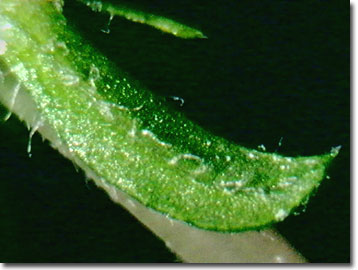Reflected Light Digital Image Gallery
Pentas (Pentas lanceolata)
Known as pentas or the Egyptian star, Pentas lanceolata are a favorite of home gardeners and landscapers in tropical and subtropical settings. These flowering plants, featuring inflorescences of white, red, lavender, or pink (as pictured here), bear 4-inch clusters of 0.5-inch flowers.

View a second image of a penta (Pentas lanceolata).
The leaves of pentas are oval and hairy and at 3 to 4 inches long, are usually deeply veined. Known also as star clusters, these members of the Rubiaceae family (the madders, includes the coffee tree and gardenias) derive their scientific genus and common names from the five-petaled flowers that they prolifically produce, and from their sword-like leaves. While the red and dark pink varieties attract hummingbirds, all of the varieties available commercially, and that have naturalized in places like Florida, attract butterflies. Unlike angiosperm flowers that feature bilateral symmetry, which is key to attracting bee pollinators, the pentas exhibit the radial symmetry attractive to butterfly and hummingbird pollinators.
Depending on the locale's microclimate, the variety, and whether the plant is shaded or in full sun, the pentas may grow upright to about 3 feet, or in a low and mounding habit. If winters are not too severe, as is true for most of the State of Florida, pentas are perennial. However, a hard freeze in an unprotected area will result in winterkill. A non-native, pentas apparently originated in Africa, but the varieties growing in the United States are the result of horticultural plantings and some natural reproduction.
These plants prefer well-drained soil, mulching, and summer irrigation. P. lanceolata is highly tolerant of heat, soil conditions, and pests, and requires little maintenance. Larger specimens are erect shrubs with woody stems while smaller plants are considered herbaceous. There are 2 to 12 setae with each seta featuring a persistent apical colleter. The leaves are opposite or whorled, depending on the variety, and there are between 3 and 5 per node. The flowers are bisexual and protandrous and the extremely reduced calyx tube favors pollinators with extendable tongues or proboscises, such as hummingbirds and butterflies. The fruit of the pentas is classified as a septicidal capsule that basipetally dehisces, while the seeds are minute, have 3 to 5 angles, and are stored in the fruit horizontally.
Contributing Authors
Cynthia D. Kelly, Thomas J. Fellers and Michael W. Davidson - National High Magnetic Field Laboratory, 1800 East Paul Dirac Dr., The Florida State University, Tallahassee, Florida, 32310.
BACK TO THE REFLECTED LIGHT IMAGE GALLERY
BACK TO THE DIGITAL IMAGE GALLERIES
Questions or comments? Send us an email.
© 1995-2025 by Michael W. Davidson and The Florida State University. All Rights Reserved. No images, graphics, software, scripts, or applets may be reproduced or used in any manner without permission from the copyright holders. Use of this website means you agree to all of the Legal Terms and Conditions set forth by the owners.
This website is maintained by our
Graphics & Web Programming Team
in collaboration with Optical Microscopy at the
National High Magnetic Field Laboratory.
Last Modification Friday, Nov 13, 2015 at 01:19 PM
Access Count Since September 17, 2002: 13748
Visit the website of our partner in introductory microscopy education:
|
|
